In 2019, the ‘Westerlo 2024’ project became official. The purchase by the Turkish businessman Oktay Ercan was just the start of what would be the financial, social and competitive rise of the Belgian team, which at that time was in the second division. Ercan decided to carry out a project with quite clear objectives to transform KVC Westerlo into one of the most complete teams in the country, with a short-to-medium-term view of becoming one of the best teams within the 16 of the Jupiler Pro League.
The appointment of the former assistant coach of Vincent Kompany at RSC Anderlecht, the young Jonas de Roeck in the 2021/22 campaign was the clearest step for the institution to achieve the first objective: promotion. They qualify in the first position of the league table. With him in his first season as their manager, they thrived to the Belgian first tier.
Not satisfied with just that, they invested in their squad with intelligent signings and very good scouting, which keeps them in seventh place in the Jupiler Pro League as it stands, with fun, purposeful and courageous football even against the greats of the competition.
That is why we are going to carry out a tactical analysis in the form of a scout report of the tactics implemented by Jonas de Roeck with Westerlo in the Belgian first division, as well as an analysis of each phase of his game.
Aggression in a mid-block
Normally when the teams play in a mid-block, even almost low, the aggression is not as clear as the teams that want to go and press high. Much of what is sought here is to wait for the rival and allow them to make the first pass, but after progression in the area where they do not want them to advance, it is where the most aggressive defensive actions will exist.
This is exactly how the Westerlo block is, with several triggers that they press but normally the majority of aggressiveness in their defensive approach is on the midfield. However, it is not only about going to cut and tackle those in charge of this area, the midfielders, but there are also other behaviours that they carry out that we are going to break down in this section.
The defensive solidity has not been one of the best in the league, with a statistic of 38 goals conceded and despite handling interesting ideas, some things should improve throughout the season. With matches ending 5-4 or 6-1 down, the numbers have swelled vastly.
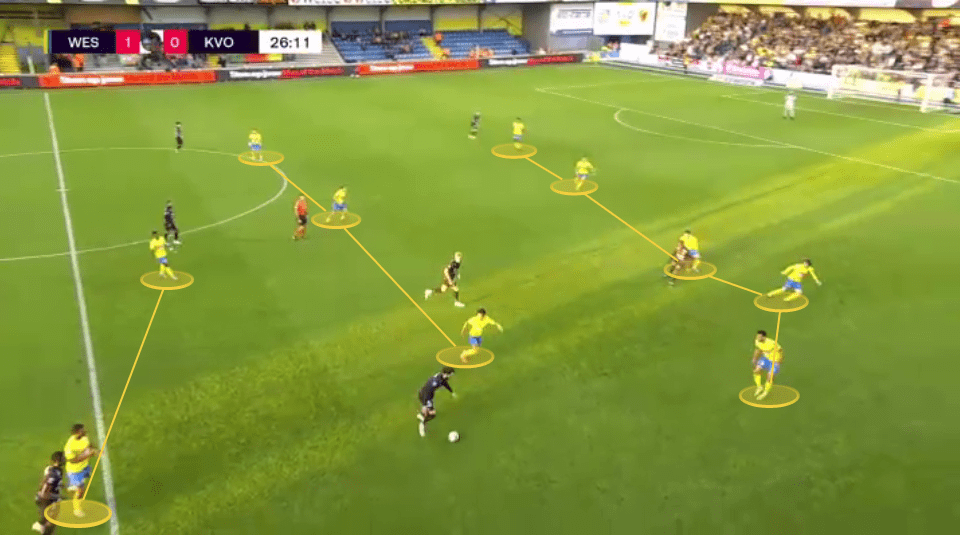
The first thing we can see in Westerlo when they seek to defend against the rival is their positioning. They do not press that high, as they prefer to close down the middle third to the opponents. The team defends in a sort of 5-3-2 that is created in a back-five as a result of former Spurs player, Nacer Chadli, the winger, which drops down the left flank and this allows the entry of Maxim de Cuyper, the full-back into the line of central defenders. However, it is something that can also happen on the other side of the formation.
The line itself does not become a total five, and the idea is that the winger is always in front of his full-back, not to his side, so that he deploys the first jump to try and win the possession, instead of the full-back so that can protect his back line. The idea of the team is that, with this positioning and help from the wingers, the teams find it extremely uncomfortable to progress on the outside.
Despite leaving three players in midfield, it may seem undersupplied but the intention here is for the players who take this place on the field to be quite aggressive with their marking, and that as soon as the ball progresses there, one of the three midfielders will go and steal the ball with great power.
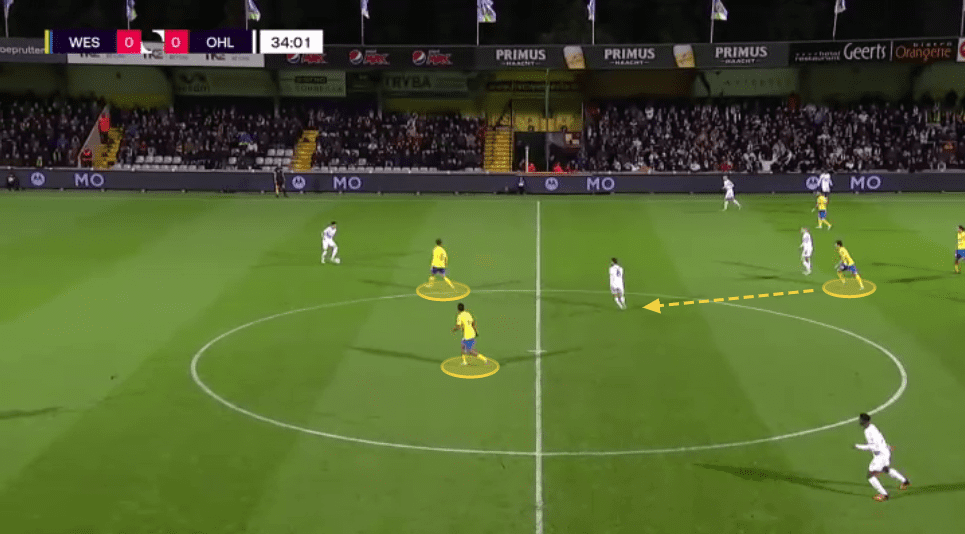
When playing in a block at medium height, the important thing is that the team travel together to one side and the other, to not allow the opponent to stretch them and find spaces. This requires high concentration and a good tactical understanding of the players to defend from behind the ball, waiting for the right moment to steal.
If the opponent gets stressed with possession, at some point they will try something new than going from side to side, so that is where, first of all, the midfielders must be extremely alert to go and steal the ball, looking to anticipate it or mark the ball receiver closely, so he doesn’t spin and preferably he forces him to restart the attack with a back-pass.
As long as the ball rolls towards the middle, midfielders are the first, but this does not take responsibility away from the central defenders or the full-backs/wingers in the same way. If the ball is played in front of them, they must be just as aggressive to steal. The point of a middle block is not to wait for them directly in the box and clear crosses and fill the penalty area, but to make defensive traps so that the players wait for the right chance to go out and make tackles.
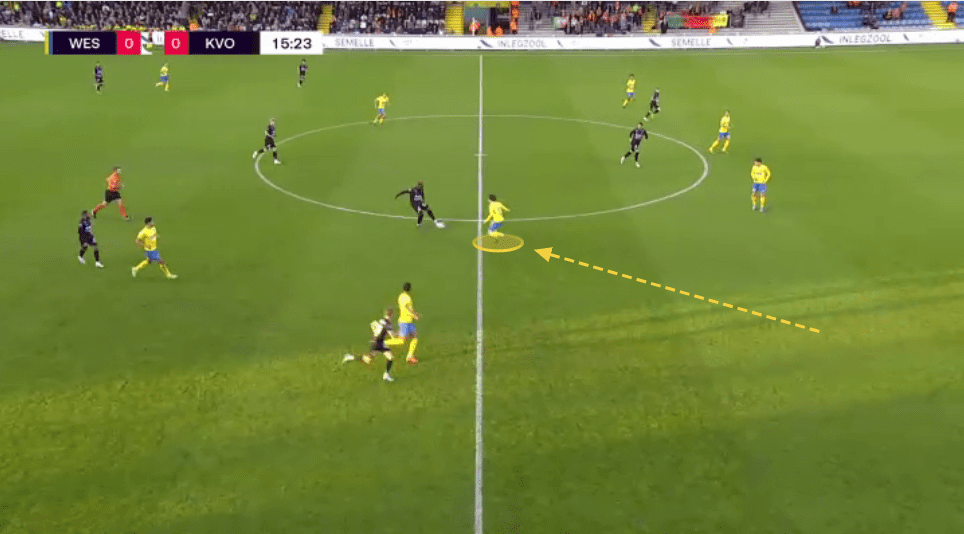
Westerlo prefers to be zonal in their approach to win the ball back, that’s for sure. One of the most important things in their defensive game is the second ball actions, where the midfielders are very attentive to hardly win the ball and make counterattacks with movements into space up-front, especially from Dorgeles Nene and Lyle Foster who combine in a great way in attack.
The Westerlo issues come from when they can’t stop certain speeds of some teams. If the block manages to spin fast or progress through and the triggers are not well timed by the players, they run into problems in this case. But it’s not just that, in fact, the main problem comes in the way they defend crosses to the box. The centre-backs have really been underperforming in this aspect which in many cases, lose track of the unmarking movements of the rivals. As soon as the rival cross is prepared, danger exists for Westerlo.
In addition, there are also problems for the central defenders, especially to cover space and their timing to close angles are not very good at all.
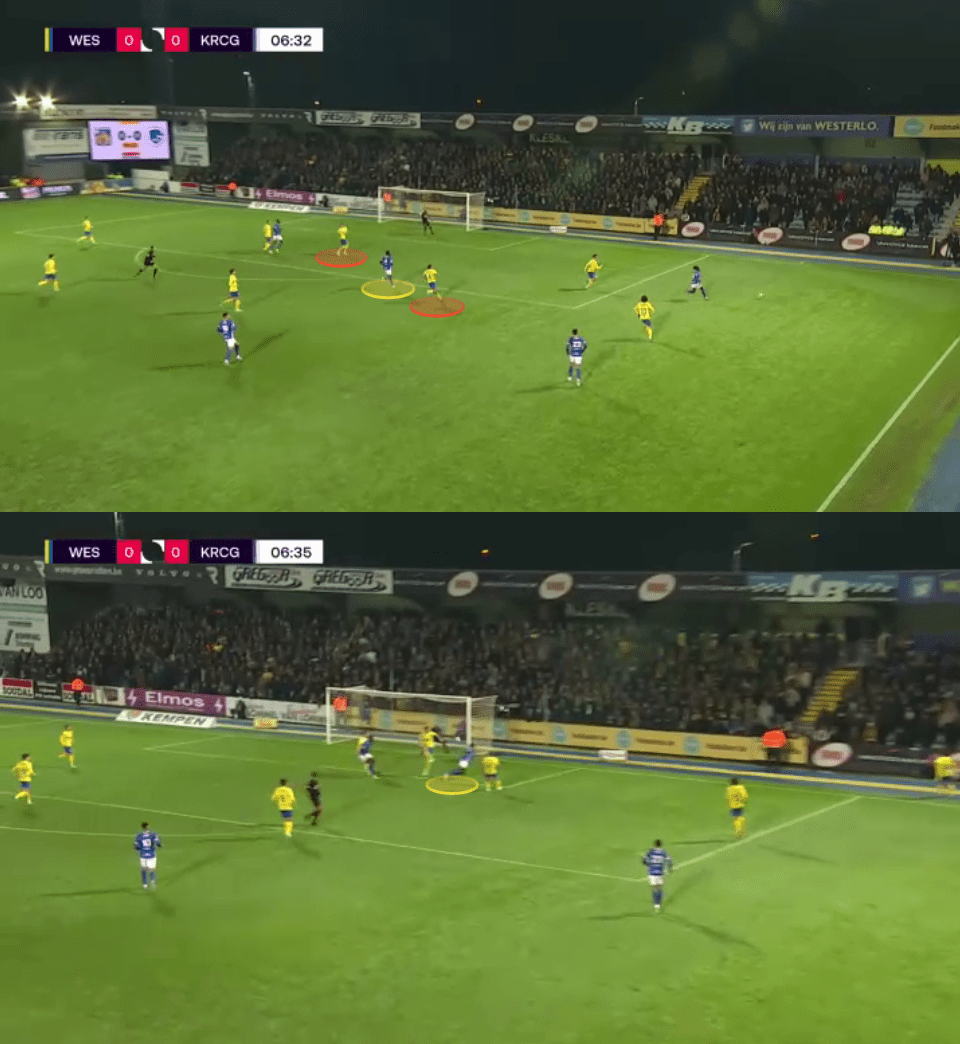
The image below shows us how little aggressive they are to defend it. Two players are close to the rival striker, who later attacks the near post looking for the cross and remains unmarked at all times. This is a sequence that happens over and over again in different Westerlo games, where they have lost a lot of points for it.
Soaking up the pressure and Plan B
Westerlo attacks in a very mobile, fun and interesting way. With several movements executed especially in the attacking front between wingers/full-backs/forwards and on occasion, midfielders who also support the construction of dangerous plays in the last third.
But what they are looking for in the early stages of the build-up is even more interesting, trying to absorb the pressure and then looking to play on the wings. They play quite a wide positioning which after the first pass to a full-back, the idea is then to play inside and turn the game forward quite quickly. Westerlo looks to create chances playing under a 4-4-2 or 4-2-3-1 which has wide-wingers, inverted full-backs and a very mobile player up-front who is always exchanging channels.
Westerlo, with its rather wide starting position, seeks to play directly with one of the full-backs, who have several plans to get out of the pressure exerted on him. The first is with a 1-2 combination from outside to inside with a midfielder, which is the main idea, but they can also go out with long balls to their own channel, as well as depending on their creativity of dribbling or ball-carrying, something that has been seen a lot, for example, on De Cuyper, the left-back.
However, when the central defender wants to play the ball, a responsibility that is also main in the first passes of the Westerlo build-up, they try to wait for the pressure, with the wide full-back doing the work of stretching the rival block and that once and for all, the ball is played to one of the midfielders, who are mobile to raise and lower their position in search of the ball.
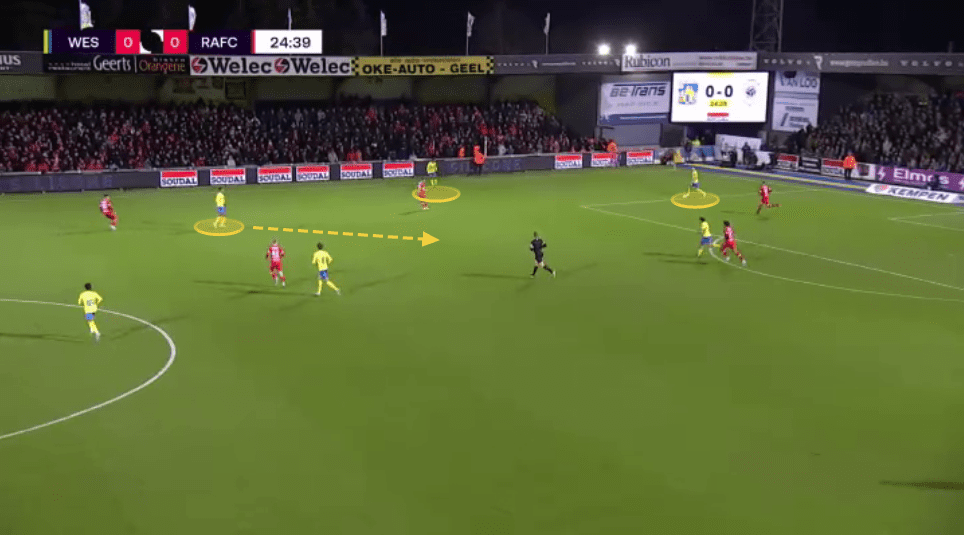
They are not shy about playing the ball inside their box under pressure from their opponents, in fact, it is something they look for regularly so when progress is made, they are quicker to reach the last third without too much trouble and a lot of pace.
However, teams are smart to recreate a plan in which they are not attracted to them having the pressure on top so they have plenty of room if they can progress through the thirds of the pitch.
Faced with, for example, teams that defend in a lower position and allow central defenders or midfielders to think, they use a lot of receptions between the lines with a player positioned in the half-space, seeking to turn the game there and then move the team higher and quicker.
This is not done directly but rather they try to invite pressure as well, with a player moving closer to the opposing players, to later move the ball to one side, and spaces are generated for this player in the half-space. It is something that we can see in the image below.
The midfielder has received alone but he has many men ahead covering the midfield, he invites some rival player to press him a bit and moves it to the side, with the central defender executing the pass towards half-space, having more space for these previous movements.
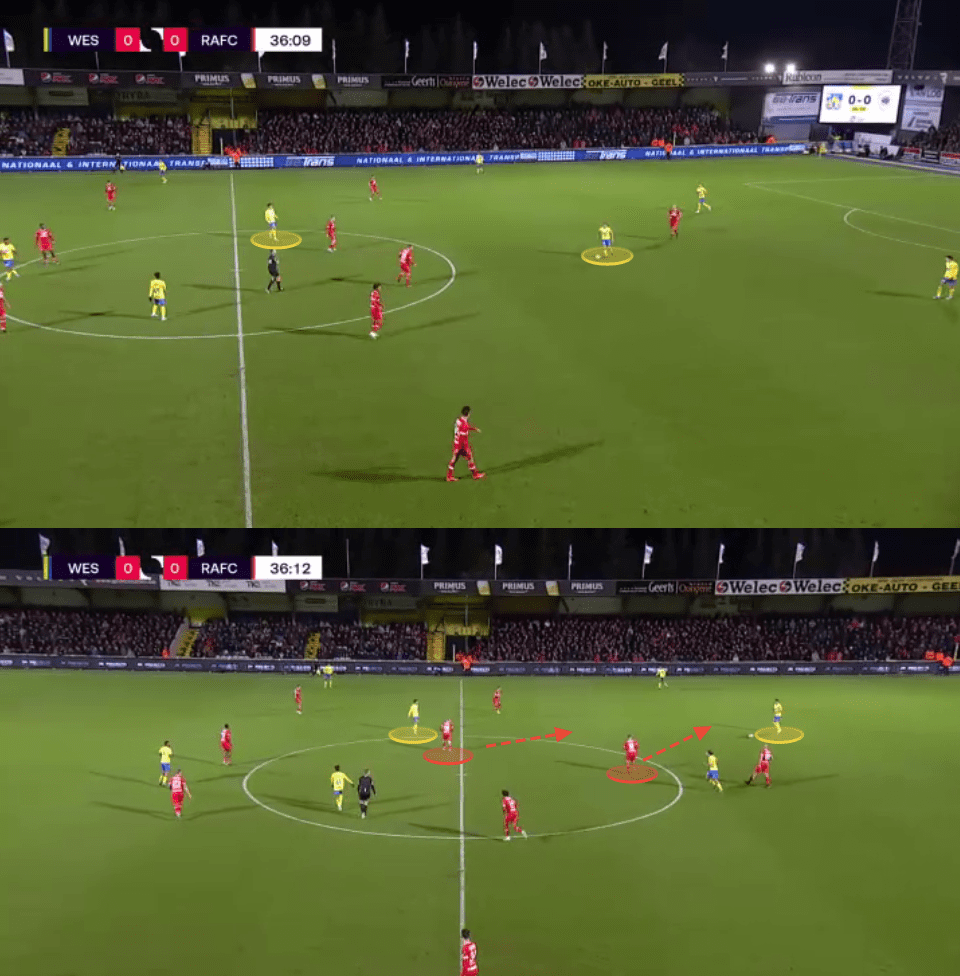
Westerlo also likes to try long balls into space. Given the good movements of Lyle Foster or Dorgeles Nene, for example, who have been an extremely vital offensive duo for the team. These types of long balls or through passes are constantly seen and make Jonas de Roeck’s football much more direct.
Just as the central defenders also seek on certain occasions not to play low, but with long balls to one of the forwards to hold up the ball and another tries to find his back. As long as the synergy of these two works well up top, Westerlo has an interesting plan B that has worked, seeking to attack more rapidly, omitting first steps.
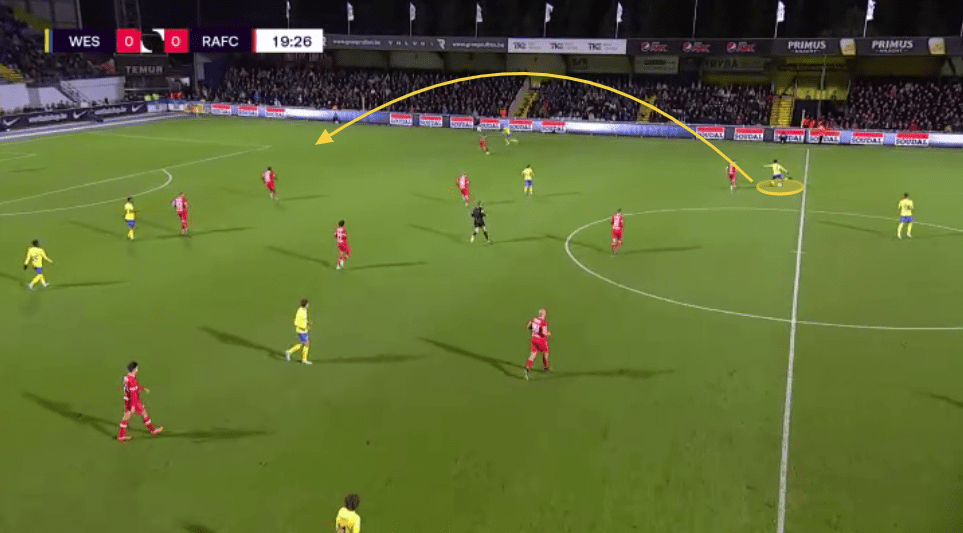
Dynamising the wings and wide mobility
Westerlo also adds wide overloads that have many channel rotations between players. One of the important figures here is Lyle Foster who offers support with his movements, but also Maxim De Cuyper using half-spaces as an inverted full-back who seeks to create more underlapping runs rather than overlaps. In fact, many of the team’s plays end with a pass from him from this zone in an outswing cross looking for the far-post or the centre of the area with powerful deliveries.
The team’s midfielders are allowed to move many yards with the ball, but what the forward pair of attackers then offers is a plus for everyone on the team. One can go and fix on the wing, he can receive and move inwards and continue generating triangulations. The idea is that there are always three players capable of rotating these channels on the outside to create rapid link-up plays and reach the rival goal.
This play that we can see below is a clear example. Given Dorgeles’ position as a winger, one of the midfielders moved the ball forward and he receives it. He dribbles inside and finds Foster, who receives and again plays towards the wing, where the midfielder who first touched exchange the position with Dorgelest. To later wait for the arrival of De Cuyper who would send a cross to the far post.
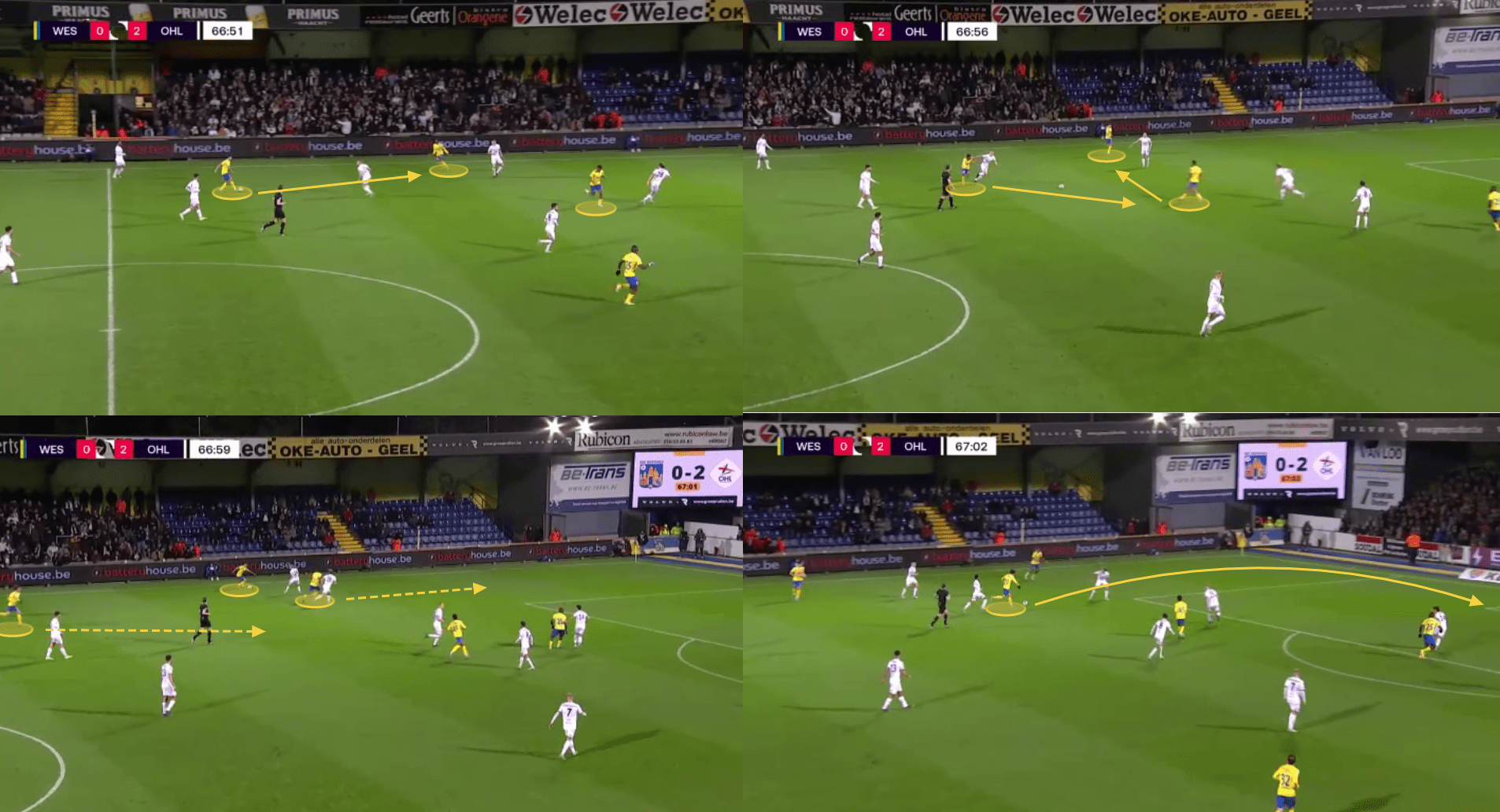
It is important to emphasize the importance and meaning of this, since Westerlo tries to fill these spaces, move the ball quickly and then make changes to the other side, either with a cross into the area or to continue circulating the ball. But they try not to make it so structured, so they generate rotations and movements between teammates.
Also, Westerlo can do it in easier ways and even further back in their own third, with the central defender moving the ball to the side, which was the first idea in possession that we explained in the section above, so that he receives and then plays inside with a midfielder who always goes there looking for support.
All this goes with the intention of generating a faster and more direct play, with the midfielder launching first-time passes into the space of his own channel. One of the strikers between Foster and Dorgeles is always making moves towards that area because they know about this type of triangulation happening on the outside, attracting and breaking into the final space.
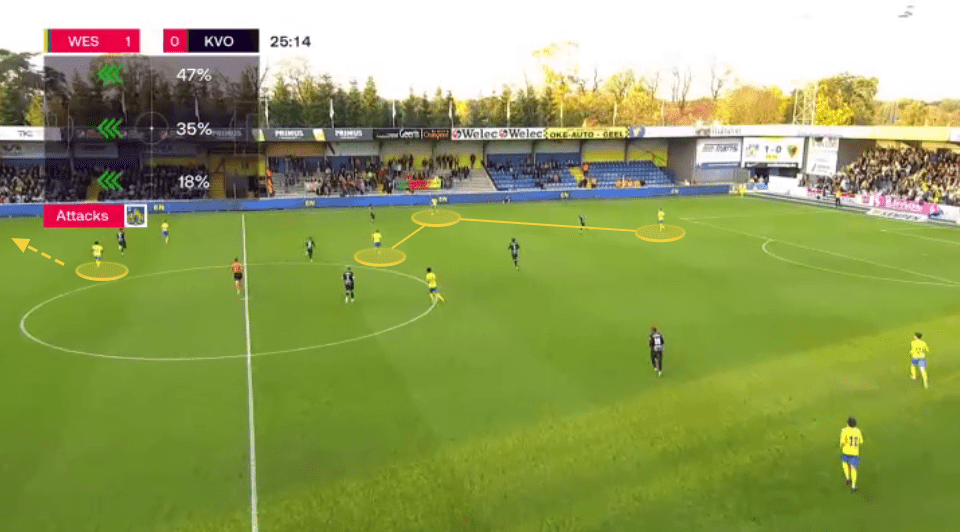
Conclusion
Westerlo has put together a really interesting project that has borne many fruits since the arrival of Jonas de Roeck, who has given the team an identity and chemistry on the pitch. In addition, signings like Lyle Foster or Dorgeles Nene, as well as Lucas Mineiro have made their squad even more interesting this season since the investment in different departments is clear.
With certain adjustments in the game, especially defensively, they could carry out a historic campaign in their promotion year in the Belgian first division, looking to qualify for the UEFA Europa League.






Comments